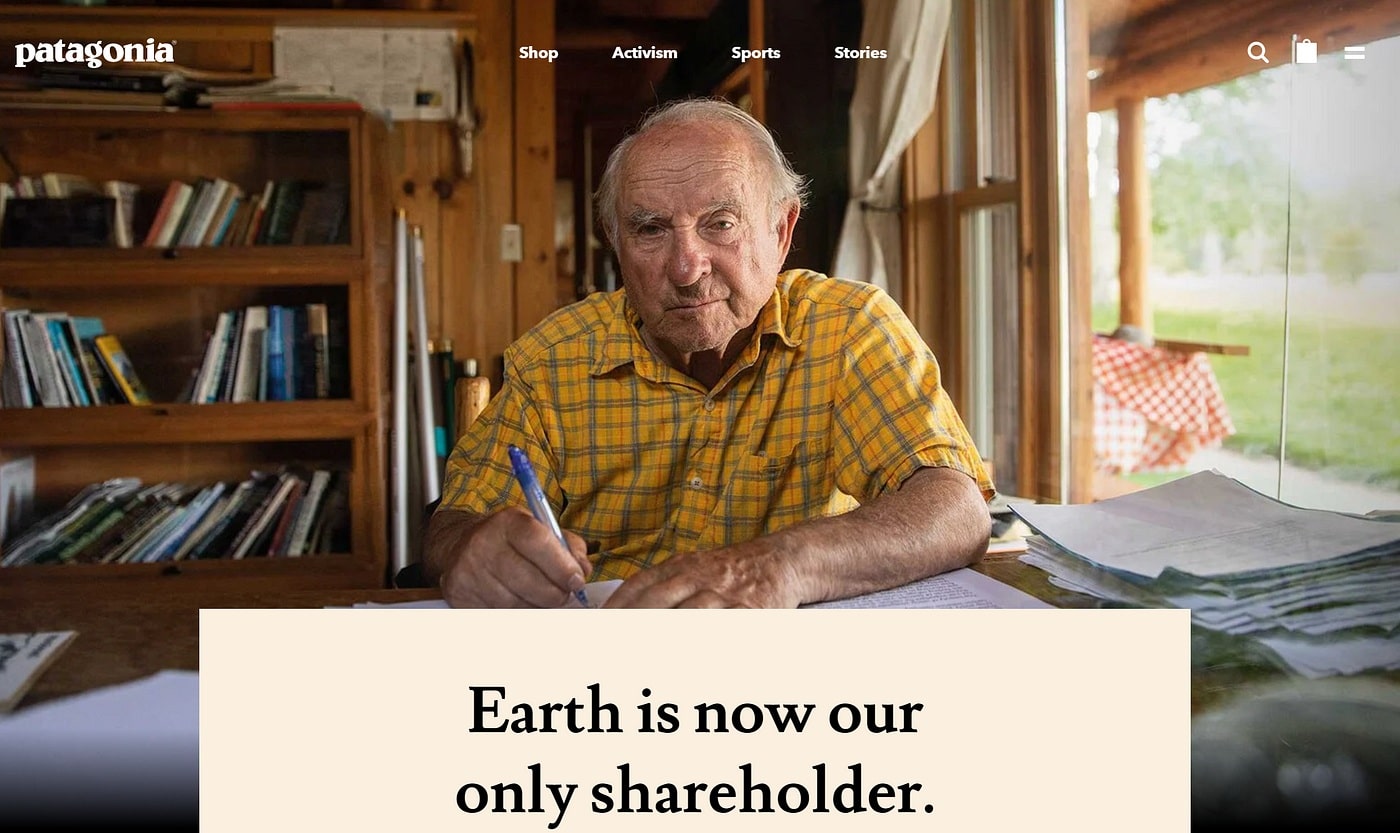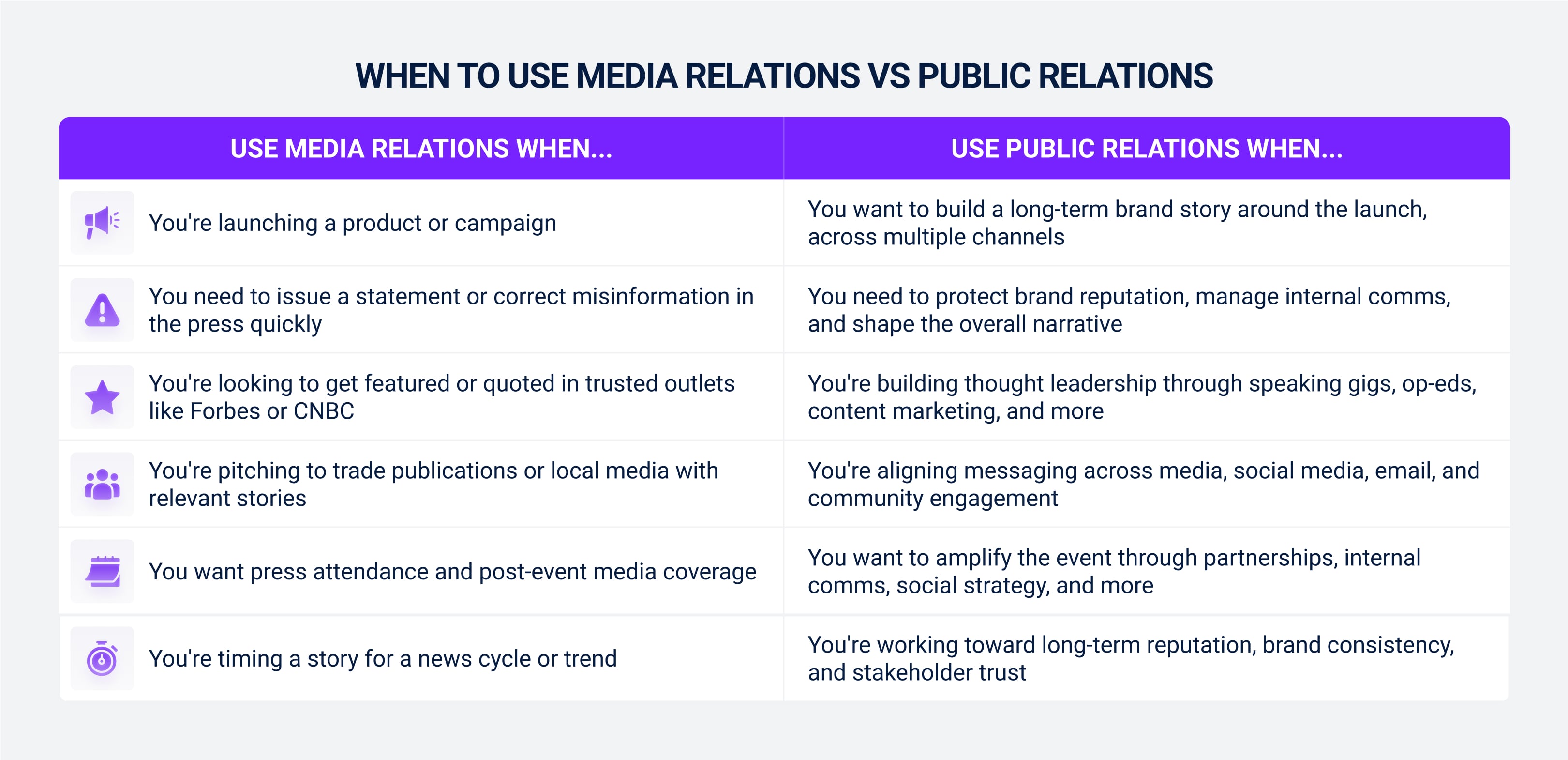If you want to promote a new business initiative, get the word out about your latest products or services, or simply create awareness for your brand, then media and public relations are probably at the forefront of your mind.
They sound similar because (in some ways) they are — media can sometimes be PR, and PR sometimes uses the press to reach its target audience. And while they share many of the same strategies, their goals are slightly different.
In this article, we'll closely examine media vs. public relations to understand their differences.
Media vs. public relations: a quick overview
Picture this: You have a new product or service that you’re excited to launch, but you need to get the word out about it.
You have a few options, including digital marketing, advertising, and content creation. But one of the best ways to amplify your brand is by earning media coverage or using public relations to get the word out.
What is media, exactly?
"Media," in the former sense of the word, refers to any form of communication that conveys information to a large audience. Think: TV, radio, newspapers, magazines, websites, and any other way you'd consume entertainment and information.
The media is what spreads news, announces events, and creates brand awareness. Traditional media outlets are often the avenue of choice for public figures and organizations who want to promote a cause to their audience en masse.
The goal of media is to get your news broadcast to the widest possible audience. Depending on the size of your company and budget, you may do this yourself (via press releases) or with the help of a public relations firm.
Media relations is the practice of building relationships between an organization and members of the press. It’s all about getting your story out to a broader audience through news coverage.
At its core, media is all about press and news coverage. Media relations focuses on getting your story out to a broader audience by working with journalists, editors, bloggers, or influencers in order to get them to write about you or your product. It’s all about building relationships with members of the press and getting them to write stories highlighting your company or product.
What is public relations?
Public relations (PR for short) is the practice of managing communication between an organization and its target audiences. It encompasses activities such as building relationships with industry influencers, creating press releases, organizing events, and more.
Like media relations, PR services aim to generate positive publicity for a company or product to boost awareness, create connections with customers, and increase sales.
Unlike media relations, the focus here is on direct communication with customers and industry influencers.
Public relations professionals focus on developing strategies to spread awareness of the company’s brand, products or services, and any relevant initiatives. It’s more than just getting media coverage—it’s also building relationships with people that have an impact on your target audience (e.g., sponsorships, partnerships, etc.).

The goal of public relations is to create a positive image and connection with customers, influencers, and the public at large. This can be done through multiple types of press releases, media interviews, speaking engagements, online content (e.g., blog posts), events, and any other type of communication that conveys your message in a favorable light.
What is the difference between media and public relations?
People often use “media relations” and “public relations” interchangeably, but they’re not the same thing.
The main difference between them is that:
PR is the full strategy. It includes messaging, brand positioning, crisis management, internal communications, and thought leadership. Media relations is one tactic. It’s about pitching stories, writing press releases, and maintaining strong relationships with the press.
Public relations (PR) is the strategy behind how a company, brand, or individual manages their reputation and builds relationships with all of their audiences — customers, employees, investors, partners, and yes, the media too.
Media relations is a subset of PR. It’s the specific practice of working with journalists, reporters, editors, and media outlets to earn coverage, whether that's a feature story, a quote in an article, or a segment on TV.
Let's take a look at a few ways media differs from PR.
Approach
Public relations takes a big-picture, long-term approach. It’s about shaping perception over time through consistent messaging, strategic storytelling, and relationship-building across multiple audiences.
Media relations, on the other hand, is often more reactive and focused. It’s about getting your message into the press at the right time, with the right angle, for the right story.
With media relations, the sole focus is on the press. Media relations strategists use different types of press releases to deliver their message, including:
- General news releases
- In-depth feature releases
- Opinion pieces
- Special events announcements
- Executive, staff, and employee interviews
When Patagonia donated its $3 billion company to fight climate change in 2022, that wasn’t just a media play. It was a full-scale PR strategy tied to their brand values, mission, and legacy. Yes, it earned massive press coverage, but the move was about more than headlines. It reinforced Patagonia’s long-term positioning as an environmental leader.

Compare that to something like Barbie’s press tour in 2023. The PR team crafted the overarching brand narrative (fun, feminist, bold), but the media relations team got Margot Robbie and the cast featured in dozens of interviews, fashion stories, and global headlines. That was media coordination at scale — a short-term, press-driven approach supporting a broader PR strategy.

Strategies
Because the two processes are inherently different, the strategies involved in each of them are also different.
A few essential steps to develop a PR strategy include:
- Identifying the target audience
- Outlining communication goals and objectives
- Developing a unique voice and brand identity
- Crafting campaigns and messages that resonate with the target audience
- Reaching out to influencers, bloggers, and other key contacts
A successful media relations strategy typically includes:
- Identifying appropriate media outlets
- Crafting targeted pitches and press releases
- Building relationships with key journalists and influencers
- Monitoring the news landscape for relevant stories to comment on
- Leveraging available technology to identify potential stories and contacts
- Connecting with press release distribution services to get the narrative out
PR strategies are much more involved and focus on a broader goal, while media strategies are more specific and designed to get the story out in one specific way.
WE ARE A FULL-SERVICE PR AGENCY
Get featured in top-tier media, build credibility fast, and attract new business with proven PR strategies that actually deliver results.
Let's talk - Schedule a call with our expert team today to see how we can help!
Implementation
Since PR focuses on managing relationships, it requires a long-term commitment and must be constantly monitored and adjusted accordingly.
The implementation of public relations is usually ongoing. It can take the form of social media campaigns, newsletters, blog posts, press releases, interviews, and speaking engagements. At different points in the overall execution, different elements will be implemented in the overall strategy.
Media strategies are less integrated because they focus solely on getting your story told in the press. After identifying the target media outlets, PR professionals craft a press release and distribute it to the appropriate journalists.
The timing of distribution is critical, though. PR pros need to ensure that their message reaches the right people at the right time. Once it’s out in the public, they monitor for results and track the campaign's progress.
Example: When Airbnb ran its “Live Anywhere on Airbnb” campaign in 2021-22, the media relations team secured coverage in Forbes, Fast Company, Business Insider, and major travel outlets. That’s textbook media outreach.
But the broader PR implementation included user-generated content from participants, branded blog posts, social storytelling, and partnerships with influencers and creators.
Reach
Regarding overall reach, comparing PR vs. advertising or PR vs. marketing is similar to PR vs. media relations. Public relations reaches stakeholders by building relationships and trust, while advertising and marketing are one-way communications.
Similarly, with media relations, you're having a one-way communication with journalists and media outlets. If they pick up your story, you get exposure to their readers, listeners, or viewers. But you don’t control how the message is framed once it’s out there.
Public relations reaches customers, employees, investors, partners, policymakers, etc., not just the media. And you do so through a joint effort between media, direct communications, thought leadership, and owned channels like your blog or LinkedIn.
Because of this, with PR, the possibilities are practically endless, allowing you to reach an even wider audience and gain more credibility from your stakeholders.
The entire concept
The most important takeaway from all of this:
PR shapes your message and manages relationships long-term. Media amplifies your story through the press, but that’s it.
When you work with us on PR, we find the message that best suits your brand and help you distribute it across owned, paid, earned, and shared channels. And we’ve got numerous tools we can use to broadcast your message.
But when it comes to increasing the reach of your message, one of the most reliable (and often cheapest) methods is still through the media. If you can tie your company's story to a current event and pitch it to the right media outlet, your story could still reach a large audience.
And since the publisher gets increased engagement without the need to find a new story, the exchange is mutually beneficial, bringing the cost down.

When to use public relations
The importance of PR is clear: it shapes the narrative about your brand and builds relationships with stakeholders. It’s also a great way to shape public opinion on what your company stands for.
A PR strategy should be used when you want to maintain influence over a particular narrative surrounding your brand. Since PR is a comprehensive strategy, it requires the resources, investment capital, and connections that media relations does not.
When to use media relations
Media relations is a great way to get your story heard by people who otherwise wouldn’t know about it. It’s also an effective way to build relationships with journalists, bloggers, and influencers in various industries.
Media relations often fits into public relations, and many companies use it as a core component of their PR strategies. But media relations can also happen in one-off instances, such as social media partnerships, bylines, and short-term marketing campaigns.
Frequently Asked Questions
Is media relations part of PR?
Media relations is one of the most essential components of public relations. It’s often used as one tactic to reach a larger audience and build relationships with journalists, bloggers, and influencers in various industries.
What is an example of media relations?
Media relations can include advertisements, social media partnerships, bylines, and marketing campaigns that come together to create cohesive customer-focused messaging. It can also involve press releases, news conferences, and media requests that boost brand visibility.

